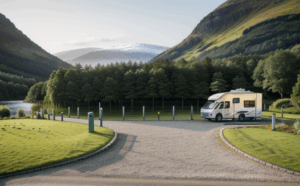A popular beauty spot in Kinross-shire, renowned for its tranquil landscapes and vibrant wildlife, is set to implement new measures to address ongoing issues with irresponsible camping. Following a decision by Perth and Kinross councillors, a two-metre-tall barrier will be erected at the entrance to the Burleigh Sands car park within the Loch Leven National Nature Reserve.
This intervention comes in response to escalating problems attributed to what authorities describe as ‘dirty camping,’ which has led to significant disruption and environmental damage over the past two years. NatureScot, the public body responsible for managing the reserve, has highlighted a range of concerns, from overflowing waste to confrontational incidents involving their staff. Mounting Pressures on a Cherished Reserve
Loch Leven Nature Reserve, a jewel in Perth and Kinross’s natural crown, draws countless visitors seeking to enjoy its scenic walks, birdwatching opportunities, and peaceful atmosphere. However, the surge in unregulated overnight stays by motorhomes and campervans has severely impacted the site’s delicate balance.
The car park at Burleigh Sands, designed for day visitors, has frequently been overwhelmed by large vehicles, leaving little room for local families, dog walkers, and day-trippers. This overcrowding has not only deterred regular users but also created a challenging environment for those dedicated to preserving the reserve’s pristine condition. Addressing Environmental and Social Impacts
NatureScot’s detailed reports to the council painted a stark picture of the consequences. The presence of numerous motorhomes, many lacking onboard sanitation, has resulted in high levels of human waste and the improper disposal of chemical waste, posing serious health and environmental risks. Compounding this, litter has accumulated, bins have overflowed, and open fires, fueled by branches and bark, have damaged ground vegetation and disturbed local wildlife.
Perhaps most concerning are the social impacts. Staff members attempting to engage with campers about responsible behaviour have faced increasing levels of aggression and confrontation. This, combined with the general deterioration of the site, has led to a noticeable reluctance among local residents to visit and enjoy an area that was once a source of community pride. Council Decision Paves the Way for Change
After careful consideration, the Perth and Kinross Council’s planning committee gave unanimous approval for the installation of the 2.1-metre-tall, 6-metre-wide barrier. The hope is that this measure will significantly reduce the number of large vehicles accessing the car park, thereby restoring its intended use for recreational day visitors and protecting the natural integrity of the reserve.
While the decision has been broadly welcomed by those advocating for the reserve’s protection, it has also sparked debate. The Milnathort and Orwell Community Council, for instance, expressed reservations during the application process. They argued that a barrier might not tackle the underlying causes of irresponsible camping and could potentially displace the problems to other nearby access roads, creating new safety concerns.
Despite these objections, councillors ultimately sided with NatureScot, acknowledging the pressing need for action. The discussion highlighted broader concerns regarding the limited powers available to authorities and landowners under Scotland’s existing access laws, especially when dealing with persistent antisocial behaviour in cherished natural areas like Loch Leven and other sites across Perth and Kinross.
As the barrier project moves forward, local residents and environmentalists in Perthshire will be watching closely, hopeful that this step will contribute to a more sustainable and respectful enjoyment of one of the region’s most beloved natural treasures.
This intervention comes in response to escalating problems attributed to what authorities describe as ‘dirty camping,’ which has led to significant disruption and environmental damage over the past two years. NatureScot, the public body responsible for managing the reserve, has highlighted a range of concerns, from overflowing waste to confrontational incidents involving their staff. Mounting Pressures on a Cherished Reserve
Loch Leven Nature Reserve, a jewel in Perth and Kinross’s natural crown, draws countless visitors seeking to enjoy its scenic walks, birdwatching opportunities, and peaceful atmosphere. However, the surge in unregulated overnight stays by motorhomes and campervans has severely impacted the site’s delicate balance.
The car park at Burleigh Sands, designed for day visitors, has frequently been overwhelmed by large vehicles, leaving little room for local families, dog walkers, and day-trippers. This overcrowding has not only deterred regular users but also created a challenging environment for those dedicated to preserving the reserve’s pristine condition. Addressing Environmental and Social Impacts
NatureScot’s detailed reports to the council painted a stark picture of the consequences. The presence of numerous motorhomes, many lacking onboard sanitation, has resulted in high levels of human waste and the improper disposal of chemical waste, posing serious health and environmental risks. Compounding this, litter has accumulated, bins have overflowed, and open fires, fueled by branches and bark, have damaged ground vegetation and disturbed local wildlife.
Perhaps most concerning are the social impacts. Staff members attempting to engage with campers about responsible behaviour have faced increasing levels of aggression and confrontation. This, combined with the general deterioration of the site, has led to a noticeable reluctance among local residents to visit and enjoy an area that was once a source of community pride. Council Decision Paves the Way for Change
After careful consideration, the Perth and Kinross Council’s planning committee gave unanimous approval for the installation of the 2.1-metre-tall, 6-metre-wide barrier. The hope is that this measure will significantly reduce the number of large vehicles accessing the car park, thereby restoring its intended use for recreational day visitors and protecting the natural integrity of the reserve.
While the decision has been broadly welcomed by those advocating for the reserve’s protection, it has also sparked debate. The Milnathort and Orwell Community Council, for instance, expressed reservations during the application process. They argued that a barrier might not tackle the underlying causes of irresponsible camping and could potentially displace the problems to other nearby access roads, creating new safety concerns.
Despite these objections, councillors ultimately sided with NatureScot, acknowledging the pressing need for action. The discussion highlighted broader concerns regarding the limited powers available to authorities and landowners under Scotland’s existing access laws, especially when dealing with persistent antisocial behaviour in cherished natural areas like Loch Leven and other sites across Perth and Kinross.
As the barrier project moves forward, local residents and environmentalists in Perthshire will be watching closely, hopeful that this step will contribute to a more sustainable and respectful enjoyment of one of the region’s most beloved natural treasures.


